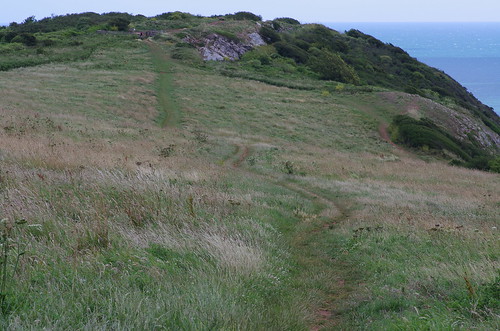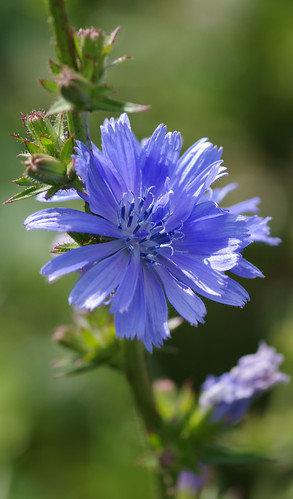One of the rarest habitats on earth
Were it not for the noticeboard just before the wooden gate, there is nothing to suggest this field is going to be any different from countless others we have wandered in and around. It tells us we are about to enter such a rare habitat there are only 22 hectares left in the U.K. I must confess I had never heard of squill-spurge fescue grassland before reading the sign. Thinking of rare habitats, I had always assumed they were endangered tracts of land in foreign exotic climes, places I would probably never visit before they died out completely.
It's hard to believe we have one virtually on our doorstep and apart from a handful of other sites around Torbay that it is found nowhere else on earth! But as the sign explains, such a specialist habitat has to be carefully managed to maintain the precise balance required. Cattle graze in the meadow at certain times of the year and further down on the cliffs, as part of the "Loving Our Limestone" project, rangers from Torbay Coast and Contryside Trust have been working to keep invasive scrub species at bay, thanks to a grant by the SITA Trust.

Swallow-tailed Moth (Ourapteryx sambucaria)
We have barely got out of the car when we have an immediate stroke of luck: there hiding on the underside of a Japanese knotweed leaf is a Swallowtail Moth. It's alarming how much the Japanese Knotweed has encroached and spread since our last visit. I remember seeing on the news last year about a pioneering project to introduce a pest that acts as a control agent on the plant in its native Japan. Tests were being done to ascertain if the insect (known as a psyllid) posed any threat to indigenous plant and insect life in the UK. I can't help wondering if these tiny insects will be introduced here to stem the tide of the knotweed invasion.
Unfortunately, the weather is keen to scupper proceedings. Outside in the garden before we left, there was barely a gentle breeze but up on the headland it's a different story, posing some very challenging shooting conditions for Sherry. The plants are being blown about all over the place, making it extremely difficult for her to take clear pictures. And even though the sun is out, the Meadow Brown butterflies stop their bobbing flight and mysteriously take refuge in the hawthorns and brambles. A quarter of an hour later, clouds appear and condense as if from nowhere, conspiring to get us drenched. The Meadow Browns clearly knew something we didn't and are obviously excellent weather forecasters (I wonder how they can sense this - can their antennae pick up a change in the atmospheric pressure?)
Before and after - while the Meadow Browns had sensibly taken cover we were left exposed to the elements.


Thankfully, on the return journey conditions cleared and the wind dropped sufficiently to allow some chicory flowers to be photographed. This site used to be a dumping ground many years ago but now in the meadow many wild flowers thrive. I look forward to returning soon to see what other species we can find.

Chicory (Cichorium intybus)

Comments
Add a Comment